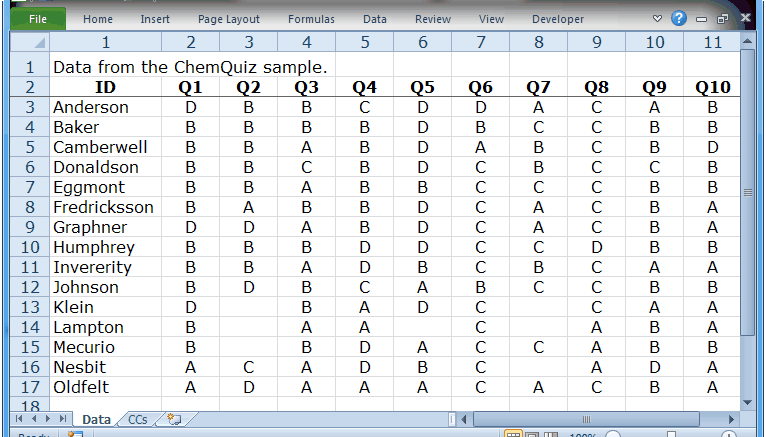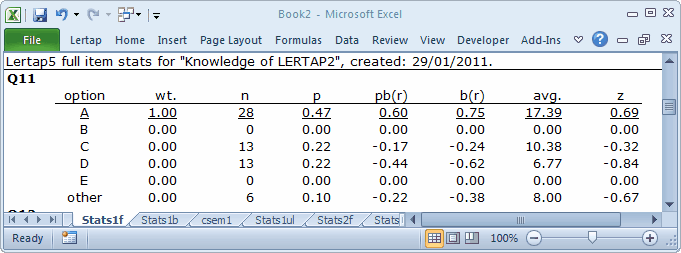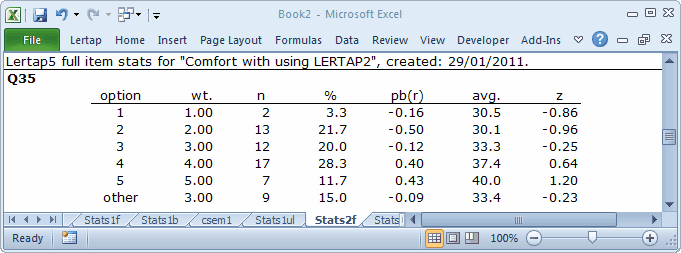Missing data
In Lertap, "missing data" is a term which usually means that a person has not answered, or has omitted, an item.
If you look at a Lertap Data worksheet and see empty cells, such cells usually indicate that there was no answer to the item corresponding to the cell. In the screen snapshot below, Klien has not answered Q2, nor Q7. Lampton has left three items unanswered (2, 5, and 7); Mecurio did not answer Q2; Nesbit has not answered Q7.

There are quite a number of users who prefer to use a special code for the case of unanswered items. Instead of leaving a cell empty, they might use a 9 to indicate missing data (there are historical reasons for this; some of the most popular data analysis programs have traditionally used 9s to represent missing data). When using scanners to process mark-sense answer sheets, the software driving the scanner may have its own missing data code, such as an asterisk (*); some scanners will code missing data and invalid responses with a Z. (A common invalid response for a scanner arises when a student has shaded in more than one response on the answer sheet.)
To fully understand how Lertap processes missing data, it helps to have a good understanding of what Lertap calls "response codes".
The letters (or digits) seen under a Lertap Data worksheet's item columns represent response codes. In the example above, it seems that items have used response codes of A, B, C, and D; this set, {A,B,C,D}, is, in fact, Lertap's default response code set for cognitive items -- for affective items, the default response code set is {1,2,3,4,5}.
It is common for users to have items which use other response codes. Whenever a test does not use the default response codes, the response codes used by that test's (or survey's) items are specified by using an Res= declaration on a *sub card.
For example, Res=(A,B,C,D,E,F), Res=(1,2,3,4,5,6,7), and Res=(t,f) are all valid Res= declarations. In Lertap, a test may use up to 26 response codes.
Now, with this understanding of response codes in hand, the definition of missing data can be made a bit more precise: in Lertap, an item response is said to be missing whenever a cell in the Data worksheet has an entry which does not match the response codes used by the item. When this happens, Lertap says it has encountered an "other" response.
As Lertap goes about tallying item responses, it keeps track of the number of "other" responses in a special bin.
What's this bin called? The "other bin", naturally. Deep inside Lertap, each and every item is assigned a storage bin for "other" responses. The contents of an item's "other" bin are displayed in many of Lertap's reports.
As an example, look at these snapshots:


In these two examples, the "other" bin for Q11 has n=6, meaning that there were six people missing data on the item. For Q35, there were n=9 people missing data.
So. Are you now full bottle on Lertap's definition of missing data? And an expert on Lertap's "other" bin?
Goodonyamate. But wait, there's more ....
What this stuff under the "wt." column? The answer to this question is also very relevant to understanding how Lertap processes missing data, especially for affective tests.
The "wt.", for "weight", indicates how many points are associated with each item option.
On Q11, the 28 people who chose response code A (usually referred to as option A, or alternative A) will get 1.00 points for their answer. Choosing any of Q11's other options gets no points. You guessed it: Q11 is a cognitive item whose right answer is A.
Not answering Q10 gets no points. Not answering Q10 gets no points. We have repeated this as it's important: an item's other bin can have scoring points attached to it.
Look at Q35, an affective item. Each and every response code has associated scoring points, and, should someone not answer Q35, they will still get 3.00 points (!).
What we've displayed in these two examples represents Lertap's default handling for cognitive and affective missing data. A cognitive item's default missing data scoring action is 0.00 points; an affective item's default missing data score is equal to the mean of the other scoring wts.
With this in mind, take a break. When you return, have a look at the following topics to read more about Lertap and missing data.
